Buffalo: A potato’s best friend
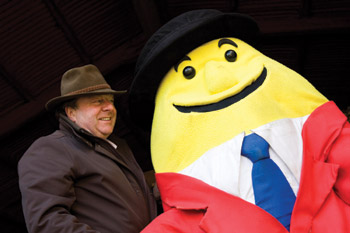
What would you think if you were driving along the N2 and saw a field of buffalo? It’s the home of Hunky Dorys of course! We talked to Largo Foods to hear how three-in-a-bed did wonders for his brand
10 November 2008
“We kill the buffalo every two or three weeks and dry the meat out until it’s bone dry. Then we macerate the product and spread it on the crisps.” Raymond Coyle, managing director of Largo Foods, tests out my gullibility reflex with this hair-raising explanation of buffalo Hunky Dorys.
Incredulous as it may sound though, Coyle does in fact keep a herd of over 250 buffalo at the Largo Foods headquarters in Kilbrew, Ashbourne, County Meath. However, he explains that he actually bought the buffalo 12 years ago, “as a wild thing to do,” (no pun intended), and decided to introduce buffalo flavoured crisps on the back of this, which “believe it or not it worked!”.
This affiliation between Hunky Dorys and Buffalo has now been cemented by a newly revamped pack design which features the buffalo logo on all varieties including the new Chargrilled Steak and Worcester Sauce flavours.
The company has spent a lot of time and effort on the Hunky Dorys brand, which Coyle reveals nearly received the name “Oakey Dokey”. This effort is not surprising, considering that Hunky Dorys is the fastest growing crisp brand according to AC Nielsen.
“A year ago it had a 12.4% value share, now it has a 13.6% value share, so that represents a 1.2% share gain which for a crisp brand is very high,” explains marketing manager Rita Kirwan. “The company wanted to refresh the brand while it was growing at its fastest, which is why we are making changes now,” she adds.
A humorous streak
Humour has played a central role in the guerrilla advertising campaign used by the brand, reflecting Coyle’s gregarious personality. Typical billboard campaigns have included a man in bed with three models, and not to be outdone in the equality stakes, the reverse scenario with a woman and three hunks.
The question posed was, “Which one would you throw out of bed for eating Hunky Dorys? Text A, B or C.” Says Coyle, “We got a huge amount of texts and a lot of media coverage from this; it’s typical guerrilla advertising because we don’t have the money to actually support the brand the way we would like to, so we’ve picked a niche media to cut through to the consumer.”
For Coyle, that a campaign “makes you smile” is essential, explaining, “It has to be funny, to make you see it when you’re driving along the road and it must also make you feel warm and have a bit of a laugh, but not be offensive.”
The family brand Tayto has also benefited from similar, although perhaps a little less risqué advertising tactics. “We wanted to make people more aware of Tayto as a fun and lively brand,” says Coyle, “So we refreshed the packaging and had two very successful ads that were supported by the media, TV and poster campaigns; namely ‘Vote Mr Tayto Number One’ and ‘The Search for Mrs Tayto’. Incidentally, for those who may be wondering, the potato icon plumped for a bachelor’s life in the end.
These campaigns were essential in helping Largo Foods retain market share, which was top priority as the business expanded, especially after acquiring Tayto.
“I was concerned about losing sales,” says Coyle, although this has changed now. “In fact the reverse is the case, the business is increasing slowly and I feel there’s going to be more snack foods consumed in these tougher times because it’s seen as a comfort food.”
Largo Foods has also impacted positively on Tayto’s sales: “Tayto was losing market share each year since Walkers arrived in 1990, [but] we were able to stop that decline, where it’s not losing market share any longer.” Coyle modestly describes his aim now as holding onto these gains. “The challenge is holding what we have”, he says, “Because the people we sell against are professional, very well funded, multinational companies so we have to be innovative with our product, offer value, quality, and try and make sure the consumer enjoys the product.” He adds, “We’re encouraged that we can grow Hunky Dorys’ market share by maybe a point a year. We’d like to leverage the brand perhaps into other snack products within the coming months, which will be bread based.”
Leader of the pack
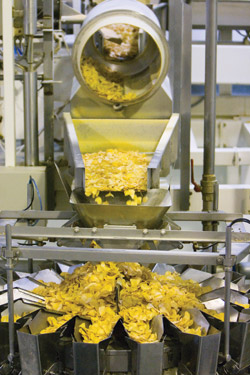
Largo spent €5.6 million on improving machinery in Kilbrew and approximately €4.2 million on building a new logistics centre there
Certainly, in value terms, the company is faring well, possessing an overall market share of 46.9%, followed by Walkers at 21% and Robert Roberts at 15%. It is not surprising that Coyle is keen to hold this dominant position, considering the company has worked hard to reach this point.
Coyle, originally from Kilbrew, started off growing potatoes for Tayto and Perri in the 1970s, later moving into the crisp-making business in 1983, in what he describes as, “a very modest way with a very small cooker.” This was at a time when “money was extremely difficult to come by, and interest rates were high.”
Says Coyle: “We hadn’t got a business, we hadn’t got volume and it was very difficult to try and build things up. Everything was against you; I think Tayto had approximately 80% market share.”
For the first two years, when the company was making own label crisps for N&N and Thrift crisps for Superquinn, Coyle says: “It was touch and go whether we’d survive or not.” However, the company had its first real breakthrough after four years when it acquired the Perri brand from the Capally family. With one brand in its portfolio, it decided to develop Hunky Dorys in 1989-90, which were actually originally intended for the UK market.
Next, Largo bought Sam Spudz in 1996 and Tayto two years ago in 2006. A significant step surely, buying the brand which has now entered into the Irish lexicon as a synonym for crisps, and for which Coyle used to grow potatoes? He explains that at the time, Largo had been making Tayto crisps under contract for C&C and when it came up for sale, “were very anxious to be able to buy it.”
He candidly admits, “If it was for sale now we wouldn’t be able to buy it, with the credit crunch. It wouldn’t make as much money obviously as it did then, but it made a different business out of our business. It gave us a buyer, and it gave us brands.”
Unashamedly Irish
Coyle didn’t actually stop growing potatoes until only two years ago, however, and still supports local producers. In total, the factory uses about 38,000 tonnes of potatoes, mostly supplied by 16 farmers within a 30 mile radius, and all its supplies apart from French sunflower oil, come from Ireland, including flavourings supplied by Kerry Foods. However, Coyle believes the company benefits just as much, if not more from this authentic Irishness.
“Ok we are supporting local producers, but we see it as an Irish crisp, made by Irish people from Irish materials…and we’re trying to play that card unashamedly to the consumer.” Other consumer concerns such as environmental credentials have similarly been addressed, with the company using its own water and treating wastewater on site. Furthermore, it has also reduced the salt content of its crisps by approximately 20% over the past four or five years.”
Investing for the future
Significant investment has been made in its machinery and processes to create a better product moreover. Largo spent €5.6 million on improving machinery in Kilbrew and approximately €4.2 million on building a new logistics centre there, while building three more plants in Donegal costing €6.1 million.
The investments should pay off in the tougher times, although, while rising commodity costs may prove a source of chagrin for the company, Coyle isn’t letting it get him down. “I’m pleased that we got support from the trade, and more importantly, the consumers in the way we approached the business. They continued to buy the product, and if they didn’t we would have been in difficulty with the whole thing.”
While “there has been a couple times in the last 24 years where we were on the edge financially… we got through it,” he says. And the proof is in the eating; Largo Foods now employs 610 people between its factories in Kilbrew and Gweedore, County Donegal and continues to invest to improve efficiency.



 Print
Print
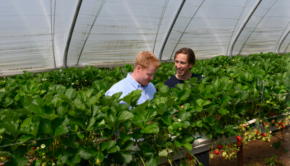

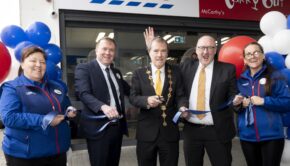
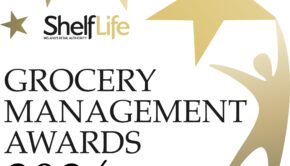


Fans 0
Followers